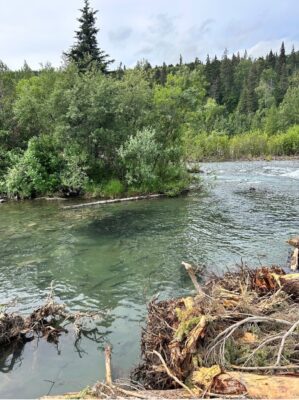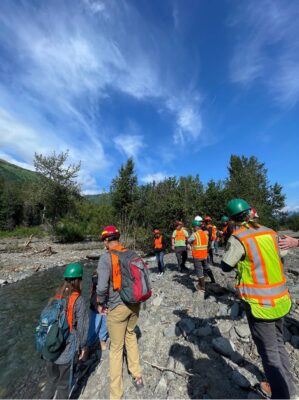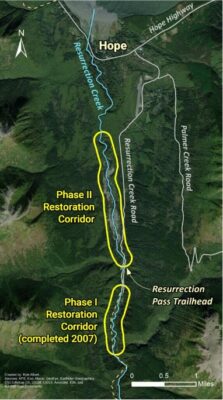A conservation organization, a mining company, and the U.S. Forest Service sit down to plan a project…
That may sound like the start of a joke, but it is the reality behind the effort to restore a salmon stream in Southcentral Alaska. A reality that came together out of ingenuity and a shared interest in caring for Alaska’s fish.

Newly watered meander on Resurrection Creek
In the winter of 2020, Alaska staff members at Trout Unlimited and Kinross Gold got together and established the Alaska Abandoned Mine Restoration Initiative with the mission of restoring fish habitat degraded by historic mining. This unique partnership was the first of its kind in Alaska.
With the Initiative launched, all that was needed was a project. They found it on Resurrection Creek in the Chugach National Forest, which provides important habitat for Chinook, coho, pink, and chum salmon, rainbow trout and Dolly Varden. Historic placer mining in the early 20th century straightened the river channel, removed important salmon spawning gravel, and significantly reduced critical spawning and rearing areas that salmon need to survive.
After almost a century of decimated salmon runs and other negative impacts to fish and wildlife, the U.S. Forest Service began restoring Resurrection Creek in 2002. Restoration was planned in two phases, and the first 1.5 mile of work was completed in 2006.
This project reconnected the historic floodplain, stream channels and riparian areas; constructed new pools, side channels and ponds; installed logs and root-wads in new stream channels; and re-vegetated the riparian areas. After completion, numbers of Chinook salmon observed in the area increased six-fold and the populations of all salmon species in the creek continue to increase.
The success of this project made it apparent additional restoration would likely have similar benefits, and the Forest Service began planning for the next phase along 2.2 miles of the lower stretch of Resurrection Creek. The plan was there—but unfortunately the funding was not, and the project sat on the shelf for 14 years.
A unique partnership between TU, Kinross, the Forest Service, the National Forest Foundation, and Hope Mining Company coalesced to jumpstart the second phase of the restoration project. The second phase of Resurrection Creek’s restoration was selected as the Alaskan Abandoned Mine Initiative’s first project. Kinross’ investment of more than $500,000 over three years helped leverage additional dollars from the state Alaska Sustainable Salmon Fund and the federal Pacific Coastal Salmon Recovery Fund, bringing the Resurrection Creek project back to life. Additional funding has since come in from NOAA and ConocoPhillips.

Placing woody debris in the new excavated channel
Construction began in the early summer of 2022 and is anticipated to be completed by 2026. This past summer of 2023, a significant portion of the new channel was constructed! Several new meanders were dug and watered, pools were dug, root wads were installed, and flood plain connectivity was restored. This work will continue in 2024 along with re-vegetation work.
This summer, several site tours and community events showed residents and visitors firsthand the significant changes occurring and the many benefits to fish habitat and the wildlife already taking place.
Immediately after in-stream work was done in mid-July, fish started utilizing the new habitat. Pink salmon rested in the freshly excavated pools and started to spawn in the new channels. Waterfowl utilized the new back–channel eddies and bears were drawn to the numerous salmon residing in the section. While there is still much to do, the immediate presence of fish and wildlife signifies a job well done!
Witnessing these benefits so early in the project is just one of the many aspects that make this project special, but none of this could be accomplished without great partnerships.
To tally it all up: We have a federal agency, two conservation nonprofits, a multi-national corporation, and a small private company all working together for the benefit of fish. Each partner fills a crucial role and brings important experience. Each is invaluable to the success of the project.

Pink Salmon fill the freshly excavated pool

Observing the new channel filled with pink salmon during the community site tour

